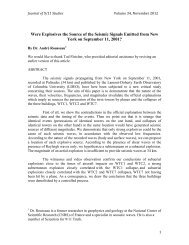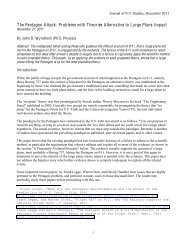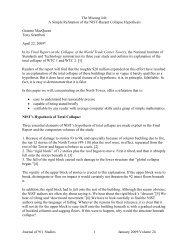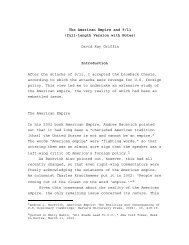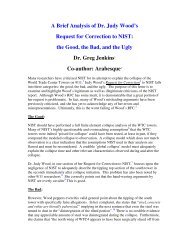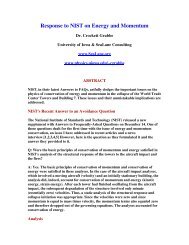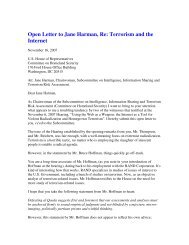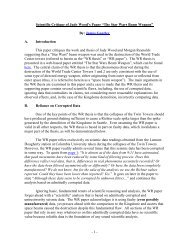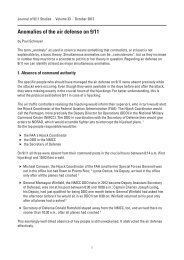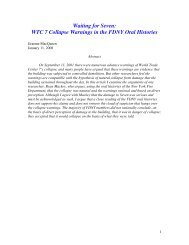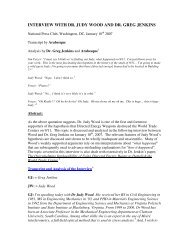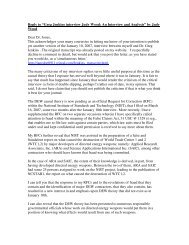Direct Evidence for Explosions - Journal of 9/11 Studies
Direct Evidence for Explosions - Journal of 9/11 Studies
Direct Evidence for Explosions - Journal of 9/11 Studies
Create successful ePaper yourself
Turn your PDF publications into a flip-book with our unique Google optimized e-Paper software.
lowering the ejection velocity v o by 25% lowers xhit by around 200 feet on the low<br />
resistivity side, and less than 100 feet on the high resistivity side. The debris material would<br />
clearly be spread over a substantial area (40 acres or more) depending its ejection velocity,<br />
its content, and how fine it was broken up when it was ejected, since several such squibs in<br />
all directions were observed. Furthermore, it is likely that explosions are also occurring<br />
after the growing dust cloud envelopes the area (e.g., higher up on the North Tower in Fig.<br />
4), so squibs producing all <strong>of</strong> that ejected material would not have been observed. This high<br />
speed material would likely damage whatever it hit on the ground, if it did not hit and<br />
damage a building be<strong>for</strong>e reaching the ground level. Figures 2 and 3 show examples <strong>of</strong> such<br />
damage when it hit vehicles at the ground level.<br />
Reference [2] reports that around 1400 cars were seriously damaged like those in Figures 2<br />
and 3. Some <strong>of</strong> the damage was because <strong>of</strong> fires started by ejections from the towers, since<br />
a number <strong>of</strong> cars were not in direct line <strong>of</strong> fire <strong>of</strong> the towers, but many were also hit at high<br />
speeds with debris. Clearly multiple explosions would be necessary to produce this damage.<br />
The damage is not likely be produced by laser directed-energy beam weapons as Judy<br />
Wood and Morgan Reynolds theorize, since the nature <strong>of</strong> destruction in that case clearly<br />
would be different: there would be evidence <strong>of</strong> melting <strong>of</strong> metal, likely burning into or<br />
through the metal, and burning <strong>of</strong> tires, but there would not be most <strong>of</strong> the surface impacts<br />
and bending and twisting <strong>of</strong> metal observed. If the tire in Figure 2 was burned <strong>of</strong>f by a<br />
laser there would likely also be evidence <strong>of</strong> laser damage to the rim. Laser damage is quite<br />
inconsistent with that <strong>of</strong> the vehicle in Figure 3, which exhibits shattered windows with no<br />
melting or burning on the exterior surface or the inside seat, and corroded material in the<br />
rear.<br />
The damage to these vehicles was most likely from being hit by a large swath <strong>of</strong> small highspeed<br />
objects <strong>of</strong> material that may have been hot and/or somewhat corrosive in nature.<br />
Many damaged vehicles, such as the one in Figure 2, show evidence <strong>of</strong> being scorched or<br />
burned by inflamed material, and both Figures 2 and 3 show possible corrosion. The<br />
windows in both vehicles were shattered, just like they were in many vehicles and in nearby<br />
buildings. It should also be noted that, similar to Figure 2, many <strong>of</strong> the vehicles clearly<br />
show damage primarily on one side or on part <strong>of</strong> the vehicle. Furthermore, photos also<br />
show shattered windows and other directed-damage in buildings <strong>for</strong> some distance from<br />
the base <strong>of</strong> the towers. This is good evidence <strong>of</strong> that the nearby vehicles and buildings were<br />
hit by "directed-energy weapons" from the tower. However, that directed energy came<br />
from the material shot out from the tower at high velocity because <strong>of</strong> explosions, rather<br />
than postulated sources like laser-beam weapons. The shattered windows and apparent<br />
impact damage in both cases provide strong evidence <strong>of</strong> being hit by material from<br />
explosives.<br />
In summary, a number <strong>of</strong> photographs show the destructive impacts <strong>of</strong> explosions on many<br />
vehicles, such as those <strong>of</strong> Figure 2 and 3, as well as on a several nearby buildings in the<br />
vicinity <strong>of</strong> the towers. Calculations using a range <strong>of</strong> estimates from observations show the<br />
destruction from these explosions range up to 1/4 mile or more in most directions. These<br />
strongly enhance the evidence presented in previous studies, such the photo in Figure 1<br />
which shows the rapidly expanding huge dust clouds from the towers resulting from



